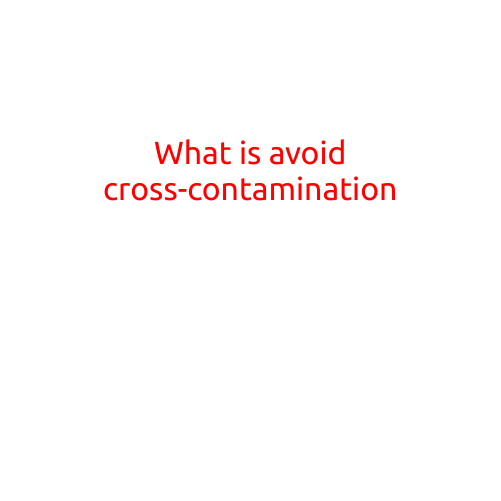
What is Avoid Cross-Contamination?
Cross-contamination is a common issue in various industries, including food service, healthcare, and manufacturing. It refers to the transfer of harmful microorganisms, substances, or chemicals from one surface, object, or person to another, potentially leading to the spread of diseases, contamination of products, or harm to individuals. In this article, we will delve into the concept of cross-contamination, its types, causes, and prevention strategies.
What is Cross-Contamination?
Cross-contamination can occur through various routes, including:
- Direct Contact: Direct contact between two surfaces or objects, such as touching a contaminated surface and then a clean surface.
- Indirect Contact: Contact between a surface or object and a person, and then transferring the contamination to another surface or object.
- Airborne Transmission: Microorganisms or particles suspended in the air and settling on a surface or object.
- Fomite Transmission: Transfer of microorganisms from a contaminated surface or object to another surface or object through touch or physical contact.
What Can Cause Cross-Contamination?
Cross-contamination can result from various factors, including:
- Poor Hygiene: Failure to wash hands, wear personal protective equipment (PPE), or maintain clean and sanitized surfaces.
- Inadequate Cleaning and Sanitization: Insufficient cleaning and sanitizing of equipment, utensils, and surfaces.
- Improper Storage: Storing food, chemicals, or biological samples in close proximity to each other.
- Lack of Training: Inadequate training on proper handling, storage, and disinfection procedures.
Types of Cross-Contamination
There are several types of cross-contamination, including:
- Foodborne Illness: Contamination of food products, leading to foodborne illnesses.
- Biological Contamination: Transfer of microorganisms or pathogens between individuals, surfaces, or objects.
- Chemical Contamination: Exposure to harmful chemicals or substances through cross-contamination.
- Industrial Contamination: Contamination of products or equipment due to inadequate manufacturing practices.
How to Prevent Cross-Contamination
Preventing cross-contamination requires a combination of proper training, good hygiene practices, and effective cleaning and disinfection procedures. Some strategies for preventing cross-contamination include:
- Implementing Personal Protective Equipment (PPE): Wearing gloves, face masks, and other PPE to prevent direct contact with contaminants.
- Following Standard Operating Procedures (SOPs): Establishing and adhering to SOPs for handling, storage, and disinfection procedures.
- Maintaining Clean and Sanitized Surfaces: Regularly cleaning and sanitizing surfaces, equipment, and utensils.
- Storing Products and Equipment Properly: Storing products and equipment in a clean, dry, and well-ventilated area.
- Providing Regular Training: Offering regular training sessions on proper handling, storage, and disinfection procedures.
Conclusion
Cross-contamination is a significant issue that can have serious consequences for individuals and organizations. By understanding the causes and types of cross-contamination, and implementing effective prevention strategies, individuals can significantly reduce the risk of cross-contamination and ensure a safer environment. Whether in the food industry, healthcare, or manufacturing, it is essential to prioritize cross-contamination prevention to protect public health and safety.





